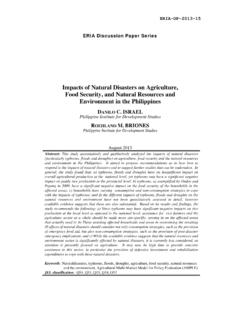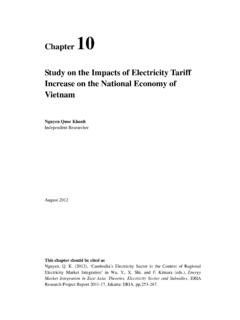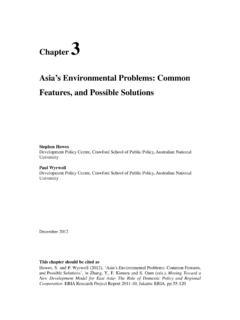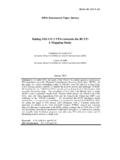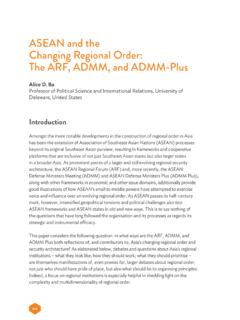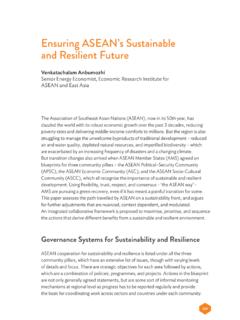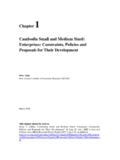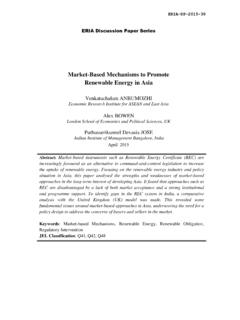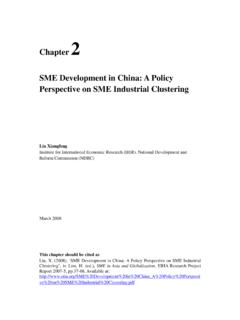Transcription of Impacts of Disasters and Disasters Risk Management in ...
1 Chapter 14 Impacts of Disasters and Disasters Risk Management in Malaysia: The Case of Floods Ngai Weng Chan Universiti Sains Malaysia, Penang, Malaysia December 2012 This chapter should be cited as Chan, N. W. (2012), Impacts of Disasters and Disasters Risk Management in Malaysia: The Case of Floods , in Sawada, Y. and S. Oum (eds.), Economic and Welfare Impacts of Disasters in East Asia and Policy Responses. ERIA Research Project Report 2011-8, Jakarta: ERIA. 503 CHAPTER 14 Impacts of Disasters and disaster Risk Management in Malaysia: The Case of Floods NGAI WENG CHAN * Universiti Sains Malaysia Malaysia lies in a geographically stable region, relatively free from natural Disasters , but is affected by flooding, landslides, haze and other man-made Disasters .
2 Annually, flood Disasters account for significant losses, both tangible and intangible. disaster Management in Malaysia is traditionally almost entirely based on a government-centric top-down approach. The National Security Council (NSC), under the Prime Minister s Office, is responsible for policies and the National disaster Management and Relief Committee (NDMRC) is responsible for coordinating all relief operations before, during and after a disaster . The NDMRC has equivalent organizations at the state, district and mukim (sub-district) levels.
3 In terms of floods, the NDMRC would take the form of the National Flood disaster Relief and Preparedness Committee (NFDRPC). Its main task is to ensure that assistance and aid are provided to flood victims in an orderly and effective manner from the national level downwards. Its approach is largely reactive to flood Disasters . The NFDRPC is activated via a National Flood disaster Management Mechanism (NFDMM). Members of the NFDRPC include Government departments/agencies and social organizations which provide shelter, rescue and food supplies in case of disaster .
4 The NFDRPC meets at least once a year, normally before the onset of the northeast monsoon. The meeting is between all organizations involved with flood disaster Management , and is focused on the need to get ready before the monsoon arrives (bringing floods with it). Its purpose is to ensure that its machinery will run smoothly. At the national level, the NSC is the secretariat for the NFDRPC which comprises members from the Ministries of Information, Finance, National Unity and Social development, Transport, the Federal Chief Secretary, the Federal Police Department and the Federal Armed Forces.
5 The NFDRPC coordinates all relief operations from the Malaysian Control Centre in Kuala Lumpur. The NFDMM is basically a mechanism responding to Disasters , as its name suggests. As such, its approach towards disaster Management / reduction is largely reactive. Because Malaysia s main risk is flooding, the NFDMM is largely targeted towards handling monsoon flooding. Consequently, this mechanism is less than effective and should be re-modeled into something more pro-active.
6 In terms of flood Management , the Drainage and Irrigation Department (DID) is the responsible agency. However, being an engineering-based organization, DID s approach is largely focused on structural measures in controlling floods. It needs to embrace a more holistic approach towards flood Management via a multi-disciplinary effort. Non-structural measures are easy to implement, less expensive and community-friendly, and need to be employed more widely. There is also a need for greater stakeholders participation, especially from NGOs at all levels in the disaster cycle.
7 Capacity building for NGOs, local communities and disaster victims is also necessary. The disaster Management mechanism should also adopt more non-structural measures, bring in state-of-the-art technology and cooperate internationally with other countries for addressing transboundary Disasters . However, the politicization and mediatization of Disasters should be controlled while disaster insurance should be introduced and disaster legislation strengthened. Keywords: disaster Risk Management , Flood Management , Malaysia, Flood Damage, Politicization of disaster The author is indebted to Universiti Sains Malaysia for funding provided in the Research University (RU) Grant 1001/PHUMANITI/816106 titled The Significance of Human factors in Effective disaster Management in Malaysia.
8 A Case Study of Flood Disasters and to the Economic Research Institute for ASEAN and East Asia (ERIA)for funding the project Economic and Welfare Impacts of Disasters in East Asia and Policy Responses which led to the publication of this chapter. * The author would like to thank ERIA for funding the writing of this chapter under the ERIA Research Project FY2011. It is also acknowledged that the data and research on flood Management was funded by Universiti Sains Malaysia under the Research University (RU) Grant 1001/PHUMANITI/816106 and FRGS Grant 203/PHUMANITI/6711198.
9 504 1. Introduction This chapter opens with a general discussion on the background and history of disaster occurrence and risk Management in Malaysia. As floods are the single most severe of all Disasters in Malaysia, the chapter specifically focuses on flood disaster Management . This is followed by an emphasis on ex post and ex ante analysis of the past and potential socioeconomic Impacts of flood Disasters in Malaysia. It then reviews and assesses the effectiveness of Malaysia s flood disaster Management system with respect to Risk Identification, Emergency Preparedness, Institutional Capacity Building, Risk Mitigation, and Catastrophe Risk Financing.
10 A detailed discussion on the current constraints that prevent people from engaging in post- disaster supports follows. Finally, the chapter ends with policy recommendations for reforms at the national level and explores the prospects for regional cooperation framework in disaster Management . of Disasters in Malaysia Malaysia lies in a geologically stable region which is free from earthquakes, volcanic activities, and strong winds such as tropical cyclones which periodically affect some of its neighbors.
